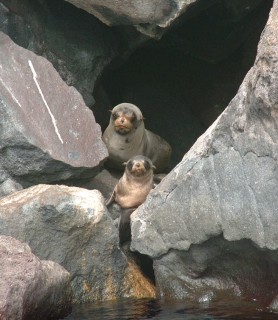
Fur seals hang out in caves and cliffs,
not beaches like the sea lions
Marine Mammals
This section features marine mammals such as whales, seals and dolphins around the world.
 Fur seals hang out in caves and cliffs, not beaches like the sea lions |
One of the great pleasures of sailing about in one’s own sailboat is the chance to see marine mammals, both at sea and along the shorelines of the islands and continents. But you don't need a sailboat to see many of these wonderful animals: in our own San Juan Islands there are numerous whale watching trips. In New Zealand and Australia you can spend the day viewing wonderful seal colonies and the migrating whales. The Galapagos Islands charters offer an amazing array of choices for seeing some of the world's most unusual marine mammals. And the small Kingdom of Tonga is home to some of the finest humpback whale watching opportunities. Chartering a boat or taking a day sail in the Caribbean, French Polynesia, Fiji, Australia or Thailand gets you out on the water where you'll likely be visited by pods of frolicking dolphins.
For reference we rely on the
National Audubon Society Guide to Marine Mammals of the World
illustrated by Pieter Folkens, 527 pages.
Photos on this website, both large and small, are copyright hackingfamily.com, credits Sue Hacking, unless otherwise noted.
Without a doubt the region richest in marine mammals was the Galapagos Islands of Ecuador. Off the coast of Isabella Island we saw an immense whale, probably a Blue Whale, escorted by a pod of jumping, breaching, playing dolphins. We were not close enough to get identification on any of them, but even from a distance of a half mile or so, they were magnificent. Here we walked beaches where dozens of sea lions played and lazed about. We swam with young sea lion males, and saw fur seals in the rocks along the island coasts.
The Galapagos Fur Seals Arctocephalus galapagoensis probably because they were hunted to near extinction in the past centuries, are more secretive than the omnipresent Sea Lions. Not technically seals, they are in fact members of the same family as the Galapagos Sea Lion, having both visible ears and use of their front flippers for swimming. Their Latin name comes from their bear-like arcto heads cephalus. They are very endearing animals to see. The fur seals are found only on the islands surrounded by the coldest waters as they are originally inhabitants of the Southern Ocean. This mother and pup were having quite a vocal argument as we approached in the panga. The pup was determined to go for a swim, whether to find some breakfast, or to see us, it's not clear. It was clear that the mother was NOT going to let the pup leave the rocky cave. Fur Seals are suited to the colder waters, having two hairs in each follicle, whereas the Sea Lions have only one, and thus are more suited to their California origins, and warmer water.
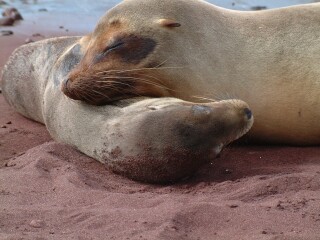 A tender moment between a mother sea lion and her pup |
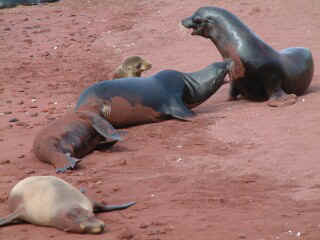 Two bull sea lions argue about just whose beach this is, and whose harem |
The Galapagos Sea Lions (a subspecies of the California Sea Lion, but smaller) are the largest land animals in the Galapagos and are present on most of the beaches. They have no fear of people, but the males can be aggressive towards not only other contenders for the title "beach-master", but also towards humans who walk or swim too near their beach. The pups, which are born after a 9-month gestation, are nursed for 5 or more months, then begin eating the normal diet of fish. The pups are restricted to playing on the beach and in shallow water, herded by the beach-master who barks his displeasure in no uncertain terms. The Spanish name for the sea lion is "lobo de mar" meaning sea wolf. So, which are they more similar to, the felines or the canines?
WHALES and DOLPHINS
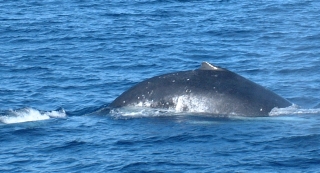 Humpback whales are so-called because of the characteristic hump-shaped back that is commonly seen above water. Humpbacks can reach a maximum length of 56 feet (17m) and weigh 45 tons. They are believed to live at least 50 years. They are found in all major oceans of the world. |
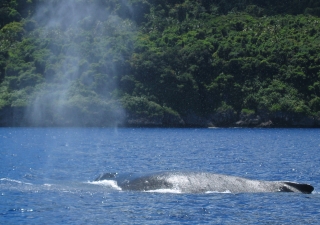 Thar she blows! The call of the old whalers was referring to the spume of breath exhaled by these marine mammals. Often, the blow is the first thing that is seen. The humpback's blow is usually low and rounded but what we saw in Tonga appeared tall and bushy. |
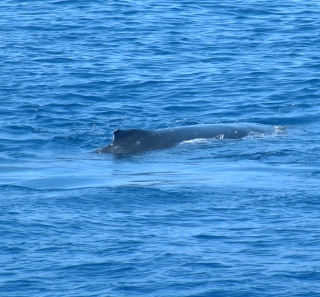 Searching for whales? Look for the "footprint", an area of smooth water near or above where a whale is swimming. We sometimes saw only the smooth water and no whale. At night off the coast of Mexico we once saw a whale surrounded by bio-luminescence which made it glow like a huge underwater spaceship. |
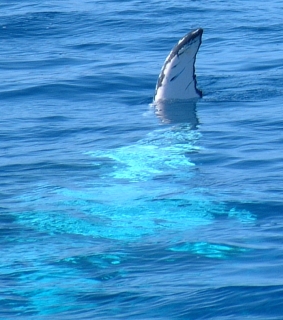 Sometimes all you can see of a humpback whale is a long fin in the air. This exceptionally long pectoral fin, up to one-third of the body length, can be seen from long distances especially when the white under-side is visible. |
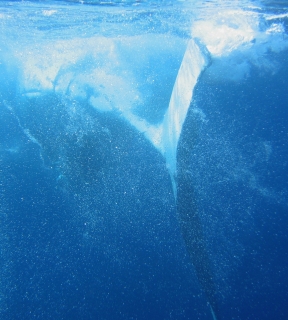 Seen from underwater, this humpback is beginning a deep dive, its white tail leaving a shining "V" just underwater. |
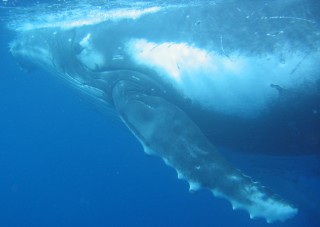 Most southern hemisphere and North Atlantic humpbacks have pectoral fins that are white on both the top and bottom but this one, photographed in Tonga, South Pacific, has a dark upper-side. Note the characteristic serrations along the side of the fin. |
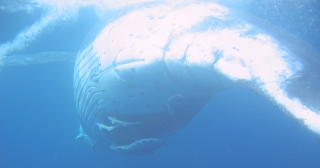 The underside of this humpback whale shows the characteristic full-length white of the southern hemisphere whales. The uro-genital slit is clearly visible. Several remora fish cling to the whale. |
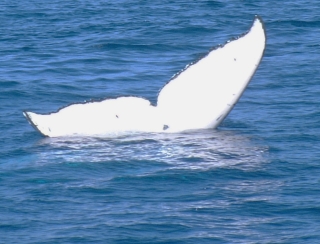 The flukes, or tails, of humpbacks are extremely variable: from all white to all black or patterned. This differentiation helps researchers identify individual animals. When initiating a deep dive humpbacks often raise their flukes above the water. |
Humpback whales are highly migratory and occur in all oceans of the world. Because of the ability to identify individual animals by the distinctive markings on their flukes, they are the best studied of all the baleen whales. Breeding takes place in the winter with 2‑20 males attending one female, and after a gestation period of about a year a single calf is born, once the mother has returned to the tropics from her summer in the Antarctic. The whales do not feed in the winter months but live off reserves stored in the blubber. The southern hemisphere humpbacks have more white on their bodies than the North Pacific animals: with long white flippers (the longest of any cetacean) and an all-white belly. These 50‑55 foot (15‑17m) animals often leap entirely out of the water (breach) landing with a great splash. They also spy‑hop (bringing their heads vertically out of the water), and lob‑tail (slap their tails on the water repeatedly). In Tonga where the calves and mothers are at risk of predation by ocean sharks, we once saw aggressive lob‑tailing followed by an attack by sharks. We never saw the sharks, but the mother was newly scarred and bleeding. Humpbacks dive with a characteristic humping of the back which reveals the small dorsal fin, and they raise their V‑shaped tails when diving. |
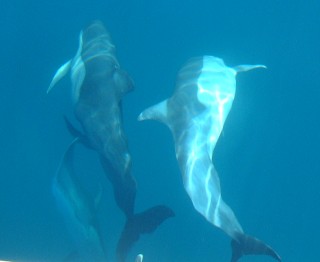 |
Playing on the bow of Ocelot near Wide Bay Bar, Queensland, Australia were these graceful dolphins, which we believe are Short-Beaked Common Dolphins Delphinus delphis. It was May, i.e. mid-autumn in the Southern Hemisphere and the water was still chilly. Our Audubon Guidebook has a "question mark" for their range off the east coast of Australia, but having good photos, especially of the dorsal, sides and belly with the complex saddle leads us to think they are the Short-Beaked Commons. Unlike the guidebook which states that the flippers are of the same color as the dorsal, these animals have dark dorsals and whitish flippers. Any help? (Queensland coast) |
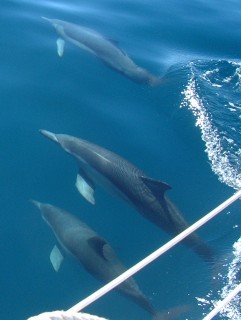 |
We were surrounded by many Common Bottlenose Dolphins Tursiops trucatas (not shown) often in our cruises around the Society Islands of French Polynesia. These playful, mostly gray animals are the classic bow-riders, often coming from a mile or more away towards our boat just to ride the bow wake. They surface and dive so close to the hulls that we have worried about hitting them, but their speed is always well in excess of our usual 6‑8 knots. Calves as well adults participate, and sometimes small groups leap together in tandem from the water. They have robust bodies, with medium-length beaks that appear to be in a perpetual smile. This is the dolphin made famous on the TV series “Flipper” and is the most common dolphin seen in aquariums around the world.
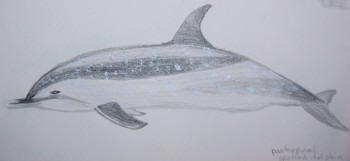 Pantropical spotted dolphin. Drawing by Sue Hacking |
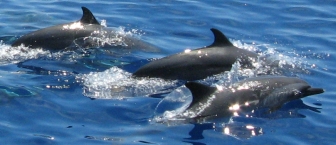 Pantropical Dolphins have a distinctive white nose |
Off the southern coast of Fiji and 300 nautical miles off the E. coast of Australia we have been visited by pods of Pantropical Spotted Dolphins Stenella attenuata playing on our bows. We observed the largest pod just to the west of Beqa Lagoon, Fiji. These animals are now abundant throughout the topics, but, like the Spinner Dolphins were killed by the hundreds of thousands by early tuna purse seiners in the eastern Pacific in the 1960’s and 1970’s. The animals have a dark back (referred to as a dorsal cape) and light belly. They are often covered in a multitude of white spots on the back and sides, and in adults, also on the dark gray, falcate dorsal fin. But some animals do not have these spots. Those that we saw in Fiji and in the Indian Ocean had a distinctive white tip to the long slim beak, a characteristic that helps identify them.
Pygmy Killer Whales Feresa attenuata (not shown) have passed our course several times in Fijian waters. Languid swimmers, they have never surfed our bow waves, and appear indifferent to our passage. These 8 foot (2.4m) black animals have a characteristic white mouth, and their melon extends all the way forward to the front of the mouth, giving them a very rounded-head look. The belly is also white, but we have never observed that, as the animals we have seen have not come close, surfed the bows, or leapt from the water. The front part of the body is heavy, with a slimmer rear. They move slowly compared to other dolphins, and appear almost leisurely in their smoothly undulating flow through the water. They are sparsely distributed around the world with the largest population believed to inhabit the eastern Pacific. In captivity they have proved to be very aggressive, attacking and killing their tank mates. Perhaps because of this behavior, they are rarely seen in the company of other cetaceans.
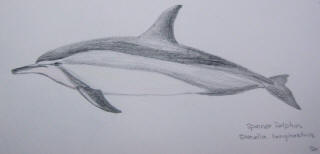 Spinner dolphin. Drawing by Sue Hacking |
Slender Spinner Dolphins Stenella longirostris have graced us with shows of their acrobatic antics off the shores of French Polynesia, and around the isolated Chagos Archipelago of the Southern Indian Ocean. In the eastern Pacific the animals have mostly light gray backs and pale bellies, with long, narrow beaks. The falcate (sickle-shaped) dorsal of some of the eastern Pacific animals can at times appear to be “backwards”, i.e. curving forwards, instead of back. The most distinctive behavior is their spinning while leaping high out of the water. They are distributed throughout the Tropics of the world, and are preyed on by Killer Whales, False Killer Whales and Pygmy Killer Whales. Many have been caught in gill-nets and shark nets.
Top Level: Home | Destinations | Cruising Info | Underwater | Boat Guests | Ocelot | Sue | Jon | Amanda | Chris | Site Map | Make a Comment
|
If our information is useful, you can help by making a donation |
Copyright © 2000‑ Contact: Jon and Sue Hacking -- HackingFamily.com, svOcelot.com. All rights reserved.